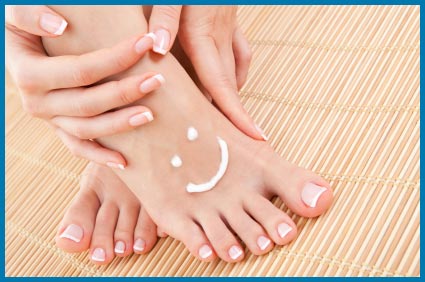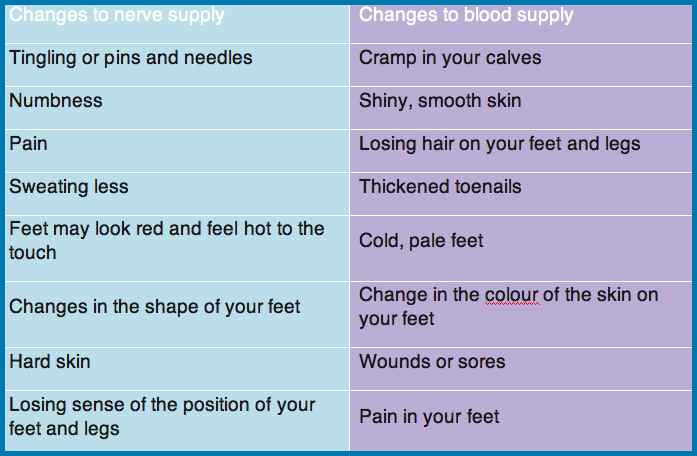What is Diabetes?
Diabetes is a serious disease that can develop from lack of insulin production in the body or due to the inability of the body’s insulin to perform its normal everyday functions. Insulin is a substance produced by the pancreas gland that helps process the food we eat and turn it into energy.
Diabetes affects approximately 200,000 people in Ireland. Many complications can be associated with diabetes. Diabetes disrupts the vascular system, affecting many areas of the body such as the eyes, kidneys, legs, and feet. People with diabetes should pay special attention to their feet.
Neuropathy
Of the 200,000 people in Ireland with diabetes, 25% will develop foot problems related to the disease. Diabetic foot conditions develop from a combination of causes including poor circulation and neuropathy. Diabetic Neuropathy can cause insensitivity or a loss of ability to feel pain, heat, and cold. Diabetics suffering from neuropathy can develop minor cuts, scrapes, blisters, or pressure sores that they may not be aware of due to the insensitivity. If these minor injuries are left untreated, they may lead to ulceration and possibly even amputation. Neuropathy can also cause deformities such as Bunions, Hammer Toes, and Charcot Feet.
It is very important for diabetics to take the necessary precautions to prevent all foot related injuries and reduce the risks of serious foot conditions. Daily observation of the feet is critical.
Poor Circulation
Diabetes often leads to peripheral vascular disease that inhibits a person’s blood circulation. With this condition, there is a narrowing of the arteries that frequently leads to significantly decreased circulation in the lower part of the legs and the feet. Poor circulation contributes to diabetic foot problems by reducing the amount of oxygen and nutrition supplied to the skin and other tissues, thus impairing the healing process and possibly leading to ulcer formation, infection and other serious foot conditions.
Signs to look out for:
Because damage to the nerves and blood supply to your feet happens gradually, it’s important to know what to look for and how to spot the signs of any change.
By checking your feet regularly you can spot the signs of any damage early. This means that you can get help quickly and can prevent the damage from getting any worse. There are a number of different things for you to look out for. These are the main ones.
| Changes to nerve supply | Changes to blood supply |
| Tingling or pins and needles | Cramp in your calves |
| Numbness | Shiny, smooth skin |
| Pain | Losing hair on your feet and legs |
| Sweating less | Thickened toenails |
| Feet may look red and feel hot to the touch | Cold, pale feet |
| Changes in the shape of your feet | Change in the colour of the skin on your feet |
| Hard skin | Wounds or sores |
| Losing sense of the position of your feet and legs | Pain in your feet |
As well as the symptoms, which you might spot yourself, your podiatrist will also be testing for changes to your feet. When you go to your diabetes review he or she will look for changes to your nerves and the blood supply as well as checking the shape and condition of your feet. If you see or feel any of these changes when you are checking your feet it’s important to get advice. Make an appointment to see your podiatrist/ doctor. Don’t put it off – the sooner you get help, the fewer problems you are likely to have.
 What changes to my feet am I looking for?
What changes to my feet am I looking for?
There are two main ways that foot problems can start – because of an injury like a cut, or a blister caused by shoes rubbing or because of hard skin. Check your feet for:
- Any damage to your skin, like a cut, blister, burn or scald. These injuries can take a long time to heal if you have diabetes and sometimes these wounds can become infected. Occasionally an infection can become serious.
- Hard skin. This builds up on the parts of your feet where there is a lot of pressure or repeated pressure, for example where your shoes or socks rub on your skin. If an area of hard skin builds up, then the pressure on the skin under it starts to increase. This causes damage to the tissues underneath. Eventually this pressure can cause a wound to form under the hard skin.
Any area of skin on your feet and toes could potentially become damaged but there are some places where your skin is more at risk.
These are areas to keep a close eye on when you check your feet:
- The ball of your foot (the underneath of your foot just below your toes) -this is an area where your skin is under a lot of pressure, because when you walk much of your weight is on the ball of your foot.
- Any areas where your bones might stick out – for example if you have a bunion or hammer toes. Your skin can become damaged on the areas that stick out if your shoes don’t fit well.
- Places on your feet where shoes or socks might rub- when you walk your shoes and socks can rub backwards and forwards over your skin which creates forces, like friction. These forces cause your skin to become pulled and stretched, which damages the blood supply and your skin.
What can I do to prevent foot problems?
Preventing problems starts with managing your diabetes well, leading a healthy lifestyle and keeping your blood glucose levels well controlled. By doing this you can prevent or slow down any changes to the nerves and blood vessels that supply your feet and legs.
Also important is good, regular foot care, which means taking care of your feet everyday and taking steps to prevent damage to your skin. This means preventing the build up of hard skin and protecting your feet from injury. Washing and moisturising your feet every day will keep the skin supple and healthy, checking them daily will help you to spot any injury or skin damage quickly.
If you have any concerns with your feet contact your podiatrist.
How to look after your feet:
Check your feet daily
You’re looking for any changes from yesterday as well as the previous days and weeks. Check for:
- Swelling
- Redness
- Any other change in the colour of your skin – for example, pale, bruised or purple skin
- Injuries like blisters or cuts
- Fluid coming from any wound
- Pain – especially if you usually have little or no feeling in your feet If you find it difficult to bend down or lift your feet up to check properly then use a mirror. Put it on the floor so you can see the soles of your feet. Or ask someone else to look for you – your partner or carer for example. Small injuries like cuts and grazes can often be looked after by you at home. Clean the injury and put on some antiseptic cream and a dry, sterile dressing. Check the injury regularly and if you see signs that it is infected (redness, swelling or fluid coming from the wound) see your Podiatrist/GP straightaway. If you spot any other changes to your feet that last for more than two days, see your Podiatrist/GP.
- Wash your feet with warm water and soap
Check the temperature of any water before you put your feet in it, to make sure it’s not too hot. You can do this by dipping your elbow or hand in.
- Use a mild normal soap or cleanser to clean your feet. Don’t soak your feet, for example don’t spend too long soaking in the bath. Soaking makes your skin soggy which means it can be easily damaged.
- Dry your feet well, taking care to dry well between your toes.
- Use a moisturizer
 Ask your podiatrist/pharmacist for a moisturiser that you can use for dry skin. There are moisturising creams available just for the skin on your feet. Don’t
use moisturiser between your toes as it will make your skin there moist, which could make an infection like athlete’s foot more likely. If you use talc, only use a small amount as it can become clogged up, which increases your chances of developing an infection.
Ask your podiatrist/pharmacist for a moisturiser that you can use for dry skin. There are moisturising creams available just for the skin on your feet. Don’t
use moisturiser between your toes as it will make your skin there moist, which could make an infection like athlete’s foot more likely. If you use talc, only use a small amount as it can become clogged up, which increases your chances of developing an infection.
Everyone who has diabetes should have his or her feet checked regularly by a qualified podiatrist.
By always going to your appointments you will be able to find out about any problems early and can get advice on foot care, shoes and any problems you may be having. Even if you think a problem may be small or not worth worrying about, always tell your podiatrist if you notice any changes to your feet.
This simple, quick and easy foot care routine can help you to keep your feet in great condition. By looking after your skin, taking a few simple precautions and by planning ahead you can help to prevent foot problems in the years to come.
Take the first step towards healthy feet for life and put your feet first!

